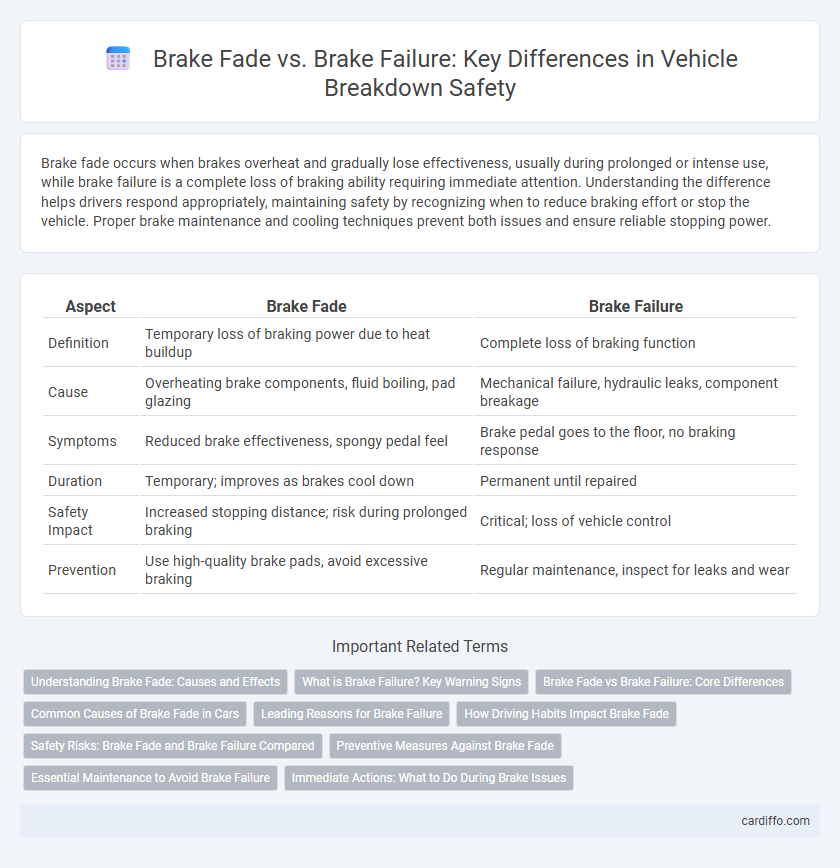Brake fade occurs when brakes overheat and gradually lose effectiveness, usually during prolonged or intense use, while brake failure is a complete loss of braking ability requiring immediate attention. Understanding the difference helps drivers respond appropriately, maintaining safety by recognizing when to reduce braking effort or stop the vehicle. Proper brake maintenance and cooling techniques prevent both issues and ensure reliable stopping power.
Table of Comparison
| Aspect | Brake Fade | Brake Failure |
|---|---|---|
| Definition | Temporary loss of braking power due to heat buildup | Complete loss of braking function |
| Cause | Overheating brake components, fluid boiling, pad glazing | Mechanical failure, hydraulic leaks, component breakage |
| Symptoms | Reduced brake effectiveness, spongy pedal feel | Brake pedal goes to the floor, no braking response |
| Duration | Temporary; improves as brakes cool down | Permanent until repaired |
| Safety Impact | Increased stopping distance; risk during prolonged braking | Critical; loss of vehicle control |
| Prevention | Use high-quality brake pads, avoid excessive braking | Regular maintenance, inspect for leaks and wear |
Understanding Brake Fade: Causes and Effects
Brake fade occurs when the braking system's effectiveness diminishes due to overheating, often caused by prolonged or intense braking that raises the brake component temperatures beyond optimal levels. The primary causes include excessive friction heat buildup in brake pads, rotors, and drums, leading to reduced friction coefficient and partial loss of braking power without complete system failure. Understanding brake fade is crucial for maintaining vehicle safety, as it differs from brake failure, where the system loses braking capability entirely due to mechanical or hydraulic malfunction.
What is Brake Failure? Key Warning Signs
Brake failure occurs when a vehicle's braking system loses the ability to slow or stop effectively, posing serious safety risks. Key warning signs include a spongy brake pedal, reduced braking power, unusual noises such as grinding or squealing, and brake warning lights on the dashboard. Ignoring these symptoms can lead to complete brake malfunction and increase the risk of accidents during breakdown conditions.
Brake Fade vs Brake Failure: Core Differences
Brake fade occurs when the braking system loses effectiveness due to heat buildup, causing reduced stopping power without complete loss of function. Brake failure is a total loss of braking capability, often caused by mechanical issues such as fluid leaks, worn brake pads, or hydraulic system failure. Understanding the difference is crucial for diagnosing vehicle performance problems and ensuring timely maintenance to prevent accidents.
Common Causes of Brake Fade in Cars
Brake fade occurs when the braking system loses effectiveness due to overheating, causing reduced friction between brake pads and rotors. Common causes include prolonged braking on steep descents, excessive brake fluid boiling, and worn or glazed brake pads. Understanding these factors helps prevent brake fade and maintain vehicle safety.
Leading Reasons for Brake Failure
Brake fade occurs when brake components overheat, reducing friction and stopping power, primarily caused by excessive use on steep descents or heavy towing. Brake failure arises from mechanical issues such as worn brake pads, leaking brake fluid, or damaged brake lines. Regular maintenance and timely replacement of brake components are essential to prevent these leading causes of brake failure.
How Driving Habits Impact Brake Fade
Aggressive driving habits such as frequent hard braking and riding the brakes significantly increase the risk of brake fade by causing excessive heat buildup in the brake components. Continuous downhill driving without proper engine braking further accelerates brake fade, reducing braking efficiency due to overheated brake pads and rotors. Regularly maintaining proper driving techniques and allowing brakes to cool can help prevent brake fade, avoiding potential brake failure during critical moments.
Safety Risks: Brake Fade and Brake Failure Compared
Brake fade occurs when the braking system overheats, causing a temporary loss of stopping power, significantly increasing the risk of accidents during prolonged or intense braking. Brake failure, a more severe condition, involves a complete loss of braking capability due to mechanical issues such as fluid leaks or worn brake pads, posing an immediate and critical safety hazard. Understanding the differences between brake fade and brake failure is essential for maintaining vehicle safety and preventing dangerous breakdowns on the road.
Preventive Measures Against Brake Fade
Brake fade occurs when brake components overheat, reducing friction and braking efficiency, while brake failure involves a complete loss of braking ability due to mechanical or hydraulic issues. Preventive measures against brake fade include regular inspection of brake pads and rotors, using high-quality brake fluids with high boiling points, and avoiding prolonged or aggressive braking to maintain optimal temperature levels. Ensuring proper ventilation in braking systems and upgrading to performance brake components can also reduce the risk of brake fade during intensive driving conditions.
Essential Maintenance to Avoid Brake Failure
Regular inspection and timely replacement of brake pads and fluid are essential to prevent brake failure and ensure vehicle safety. Brake fade, caused by overheating, can be minimized by maintaining proper brake cooling and avoiding excessive braking on steep declines. Consistent maintenance and prompt attention to any signs of reduced braking performance help avoid dangerous breakdowns on the road.
Immediate Actions: What to Do During Brake Issues
During brake fade, reduce speed gradually by downshifting to lower gears and gently applying the brake to prevent overheating. In case of brake failure, use the emergency brake cautiously while steering towards a safe area and avoid sudden turns. Stay calm, signal other drivers, and seek professional assistance as soon as possible to ensure safety and prevent accidents.
Brake fade vs brake failure Infographic

 cardiffo.com
cardiffo.com